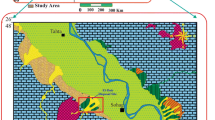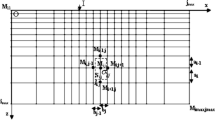Abstract
Electrical resistivity tomography (2D ERT) is a powerful tool for the diagnosis of the subsoil state and to pursue an environmental monitoring in time to detect and follow a temporal evolution of plumes in hydrocarbon-contaminated soils. In situ, 2D ERT was conducted to investigate the electrical properties of the subsoil in three petrol stations in Murcia semiarid Region (SE Spain), which have been active for many years, in order to look for anomalous areas that could be related to the presence of a non-aqueous phase liquid (NAPL) contaminant plume in the subsoil. A total of 18 ERT profiles in wet and dry season were conducted to study the seasonal effects in the resistivity values of the subsoil. Dipole–dipole array was set up to make the soil diagnosis, achieving a good vertical and lateral resistivity distributions for the sites investigated. Interpretations obtained from ERT pseudo-sections, after a processing and inversion data process with PROSYS II and RES2DINV software, show delimited highly resistive regions above 2,000 Ω·m at 2 m deep related to the underground storage tanks (USTs) position and the filling ports and anomalous resistivity areas where boreholes and further GC–FID determination in soil samples have been done. No significant differences have been found between results obtained in dry and wet seasons. Thus, the geo-electrical non-destructive technique ERT is presented as a tool to delineate the USTs positions and to point out anomaly in the subsoil that could contain NAPL, helping to design sampling strategies, saving cost and time.









Similar content being viewed by others
References
Acosta, J., Martínez-Martínez, S., Martínez-Pagan, P., Zornoza, R., Carmona, D., & Faz, A. (2011). Estudio de estabilidad en depósitos de lodos del Distrito Minero de Mazarrón (SE España): riesgos potenciales sobre la Rambla de Las Moreras. Boletín Geológico y Minero, 122(2), 145–160.
AEMET (2011). Agencia Estatal de Meteorología. Ministerio de Medio Ambiente y Medio Rural y Marino. http://www.aemet.es/es/portada. Accessed March 2011.
Ananyan, A. (1961). Permafrost studies (in Russian). Academy of Science of USSR Press, 1, Moscow.
Atekwana, E., Sauck, W., & Werkema, D. (2000). Investigations of geoelectrical signatures at a hydrocarbon contaminated site. Journal of Applied Geophysics, 44, 167–180.
Baedecker, M., Cozzarelli, I., Eganhouse, R., Siegel, D., & Bennett, P. (1993). Crude oil in a shallow sand and gravel aquifer—III. Biogeochemical reactions and mass balance modelling in anoxic groundwater. Applied Geochemistry, 8, 569–586.
Börner, F., Gruhne, M., & Schön, J. (1993). Contamination indications derived from electrical properties in the low frequency range. Geophysical Prospecting, 41, 83–98. doi:10.1111/gpr.1993.41.issue-1.
Bussian, A. (1983). Electrical conductance in a porous medium. Geophysics, 48, 1258–1268.
Campbell, D., Lucius, J., Ellefsen, K., Deszcz-Pan, M. (1996). Monitoring of a controlled LNAPL spill using ground-penetrating radar. In Bell, R.S, Cramer, M.H. (Eds.) Proceedings of the Symposium on the Application of Geophysics to Engineering and Environmental Problems (SAGEEP 1996) (pp. 511-517). Keystone.
Cassidy, D., Werkema, D., Sauck, W., Atekwana, E., Rossbach, S., & Duris, J. (2001). The effects of LNAPL biodegradation products on electrical conductivity measurements. Journal of Environmental and Engineering Geophysics, 6(1), 47–52.
Chang, C., Sommerfeldt, T., Carefoot, J., & Schaalje, G. (1983). Relationships of electrical conductivity with total dissolved salts and cation concentration of sulphate-dominant soil extracts. Canadian Journal of Soil Science, 63, 79–86.
Cozzarelli, I., Eganhouse, R., & Baedecker, M. (1990). Transformation of monoaromatic hydrocarbons to organic acids in anoxic groundwater environment. Environmental Geology and Water Sciences, 16, 135–141.
Dahlin, T., & Zhou, B. (2004). A numerical comparison of 2D resistivity imaging with 10 electrode arrays. Geophysical Prospecting, 52, 379–398.
Daily, W., Ramirez, A., LaBrecque, D., & Nitao, J. (1992). Electrical resistance tomography of vadose water movement. Water Resources Research, 28(5), 1429–1442.
Daniels, J., Roberts, R., Vendl, M. (1992). Site studies of ground penetrating radar for monitoring petroleum product contaminants. In Proceedings of the Symposium on the Application of Geophysics to Engineering and Environmental Problems (SAGEEP’92) (pp. 597-609). Oakbrook.
De la Vega, M., Osella, A., & Lascano, E. (2003). Joint inversion of Wenner and dipole dipole data to study a gasoline-contaminated soil. Journal of Applied Geophysics, 54, 97–109.
De Ryck, S., Redman, J., Annan, A. (1993). Geophysical monitoring of a controlled kerosene spill. Proceedings of the Symposium on the Application of Geophysics to Engineering and Environmental Problems (SAGEEP’93) (pp. 5-20). Englewood, CO: Environmental and Engineering Geophysical Society.
Delaney, A., Peapples, P., & Arcone, S. (2001). Electrical resistivity of frozen and petroleum-contaminated fine-grained soil. Cold Regions Science and Technology, 32, 107–119.
Eganhouse, R., Baedecker, M., Cozzarelli, I., Aiken, G., Thorn, K., & Dorsey, T. (1993). Crude oil in a shallow sand and gravel aquifer. Applied Geochemistry, 8, 551–567.
Endres, A., & Greenhouse, J. (1996). Detection and monitoring of chlorinated solvent contamination by thermal neutron logging. Groundwater, 34, 283–292.
Fedinsky, V. (1967) Papel de los métodos geofísicos en la prospección y exploración de los yacimientos metalíferos en la URSS. Moscú. 41pp.
Fetter, C. W. (1993). Contaminant Hydrogeology. New York: Macmillan.
IGME. (1975). Hoja nº 954 (Totana). Mapa Geológico de España E. 1:50000. 2º serie. Madrid: Servicio de Publicaciones del Ministerio de Industria.
IGME. (1976). Hoja nº 934 (Murcia). Mapa Geológico de España E. 1:50000. 2º serie. Madrid: Servicio de Publicaciones del Ministerio de Industria.
IGME. (1981). Hoja nº 869 (Jumilla). Mapa Geológico de España E. 1:50000. 2º serie. Madrid: Servicio de Publicaciones del Ministerio de Industria.
Kalinski, R., Kelly, W., Bogardi, I., Ehrman, R., & Yaniamoto, P. (1994). Correlation between DRASTIC vulnerabilities and incidents of VOC contamination of municipal wells in Nebraska. Groundwater. doi:10.1111/j.1745-6584.1994.tb00607.x.
King, T. V. & Olhoeft, G. (1989). Mapping organic contamination by detection of clay organic processes. In Proceedings AGWSE/NWWA/API, Conference on Petroleum Hydrocarbons and Organic Chemicals in Ground Water-Prevention, Detection and Restoration (pp. 627-640). Published in CD format.
Loke, M., & Barker, R. (1996). Practical techniques for 3D resistivity surveys and data inversion. Geophysical Prospecting, 44, 499–523.
Loke, M. (2004). Tutorial 2D and 3D electrical imaging surveys. Geotomo. http://www.geoelectrical.com/index.php. Accessed January 2011.
Loke, M.H. (2000). Topographic modelling in resistivity imaging inversion. 62nd EAGE Conference & Technical Exhibition Extended Abstracts, D-2. Geotomo. http://www.geoelectrical.com/ Accessed January 2011.
MARM (2011). Sistema Integrado de Información del Agua, SIA. Ministerio de Medio Ambiente y Medio Rural y Marino. http://www.marm.es/es/cartografia-y-sig/temas/sistema-integrado-de-informacion-del-agua-sia-/default.aspx. Accessed January 2011.
Martín-Crespo, T., Martín-Velázquez, S., Gómez-Ortiz, D., De Ignacio-San José, C., & Lillo-Ramos, J. (2010). A geochemical and geophysical characterization of sulfide mine ponds at the Iberian Pyrite Belt (Spain). Water, Air, and Soil Pollution. doi:10.1007/s1127001005956.
Martínez-Pagan, P. (2006). Aplicación de diferentes técnicas no destructivas de prospección geofísica a problemas relacionados con contaminación ambiental producida por diferentes actividades antrópicas en la Región de Murcia. Doctoral thesis. Technical University of Cartagena. 476 pp.
McMahon, P., Vroblesky, D., Bradley, P., Chapelle, F., & Guller, C. (1995). Evidence of enhanced mineral dissolution in shallow groundwater. Ground Water, 33, 207–216.
Meju, M. (2000). Geoelectrical investigation of old abandoned, covered landfill sites in urban areas: model development with a genetic diagnosis approach. Journal of Applied Geophysics, 44, 115–150.
National Research Council. (1997). Innovations in ground water and soil cleanup: from concept to commercialization. Washington, DC: National Academies Press.
Olhoeft, G. (1986). Direct detection of hydrocarbon and organic chemicals with ground-penetrating radar and complex resistivity: petroleum hydrocarbons and organic chemicals in groundwater—prevention, detection and restoration: NWWA/API Proceedings (pp. 284-305).
Park, S. (2001). Site investigation technology of contaminated soil and groundwater. Journal of Korean Society of Agricultural Engineers, 43(6), 45–23.
Pernar, N., Baksic, D., Antonic, O., Grubesic, M., Tikvic, I., & Trupcevic, M. (2006). Oil residuals in lowland forest soil after pollution with crude oil. Water, Air, and Soil Pollution, 267–284. doi:10.1007/s1127000691742.
Raisov, O. (1973). Relationship of electrical resistivity and temperature for sod-serozemic solonchak (in Russian). Vestnik MGU. Biology, Soil Science, 3, Moscow University Press.
Revil, A., Cathles III, L.M., Losh, S. & Nunn, J.A. (1998). Electrical conductivity in shaly sands with geophysical applications. Journal of Geophysical research, 103(B10), 23, 925–23, 936.
Revil, A., Schmutz, M., & Batzle, M. (2011). Influence of oil wettability upon spectral induced polarization of oil-bearing sands. Geophysics, 76(5), 31–36. doi:10.1190/GEO2011-0006.1.
Schmutz, M., Revil, A., Vaudelet, P., Batzle, M., Femenía Viñas, P., & Werkema, D. (2010). Influence of oil saturation upon spectral induced polarization of oil-bearing sands. Geophysical Journal International, 183, 211–224.
Sharma, V., Hicks, S., Rivera, W., & Vazquez, F. (2002). Characterization and degradation of petroleum hydrocarbons following an oil spill into a coastal environment of south Texas, U.S.A. Water, Air, and Soil Pollution, 134, 111–127.
US EPA (2004). Underground storage tanks: building on the past to protect the future. US Environmental Protection Agency. http://www.epa.gov/swerust1/pubs/20annrpt.htm. Accessed September 2009.
US EPA 5000 (1996). Sample preparation for volatile organic compounds. US Environmental Protection Agency. http://www.epa.gov/osw/hazard/testmethods/sw846/pdfs/5000.pdf. Accessed March 2010.
Vinegar, H., & Waxman, M. (1984). Induced polarization of shaly sands. Geophysics, 49, 1267–1287.
Watillon, A., & de Backer, R. (1970). Potentiel d’écoulement, coutant d’écoulement et conductance de surface à l’interface eau-verre. Journal of Electroanalytical Chemistry, 25, 181–196.
Waxman, M., & Smiths, L. (1968). Electrical conductivities in oil-bearing shaly sands. Society of Petroleum Engineers Journal, 8, 107–122.
Weinzettel, P., Varni, M., Dietrich, S., & Usunoff, E. (2009). Evaluación de horizontes petrocálcicos en el suelo. Ciencia del Suelo (Argentina), 27(1), 135–149.
Wells, C. (1978). Electrolytic conductivity of soil solutions and wares: conversions from field to standard temperatures. Abstracts of II Int. Cong. Soil Sci. Edmonton, 1, 195–196.
Werkema, D., Atekwana, E., Endres, A., Sauck, W., & Cassidy, D. (2003). Investigating the geoelectrical response of hydrocarbon contamination undergoing biodegradation. Geophysical Research Letters. doi:10.1029/2003GL017346.
WHO, Word Health Organization (2010). Exposure to benzene: a major public health concern. http://www.who.int/ipcs/assessment/public_health/benzene/en/.
Acknowledgments
This work was carried out under 08800/PI/08 Research Project funded by the Seneca Foundation: Area Agency on Science and Technology in the Region of Murcia (Spain). Rosa Ma. Rosales is grateful to Seneca Foundation for the Research Grant/Contract for Staff Training given to her to carry out this research.
Author information
Authors and Affiliations
Corresponding author
Rights and permissions
About this article
Cite this article
Rosales, R.M., Martínez-Pagan, P., Faz, A. et al. Environmental Monitoring Using Electrical Resistivity Tomography (ERT) in the Subsoil of Three Former Petrol Stations in SE of Spain. Water Air Soil Pollut 223, 3757–3773 (2012). https://doi.org/10.1007/s11270-012-1146-0
Received:
Accepted:
Published:
Issue Date:
DOI: https://doi.org/10.1007/s11270-012-1146-0




